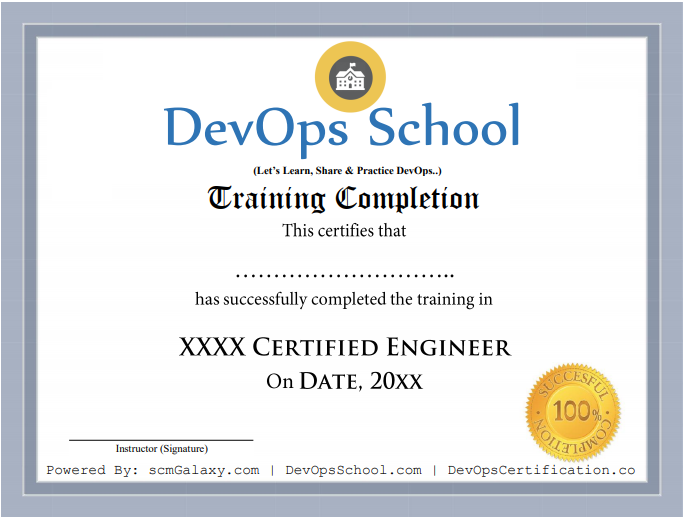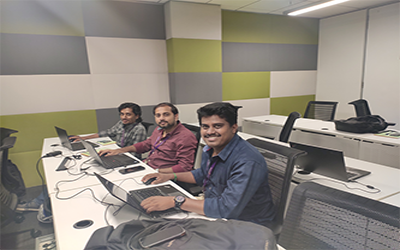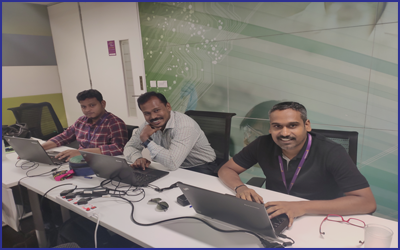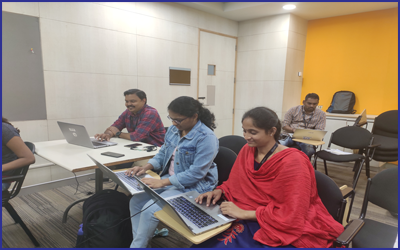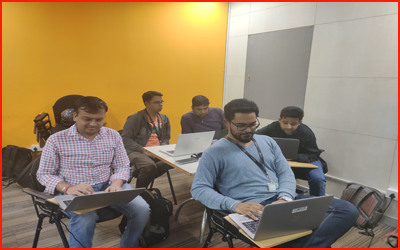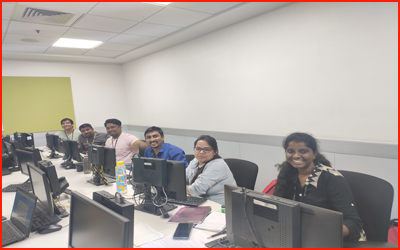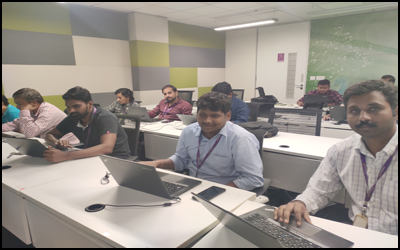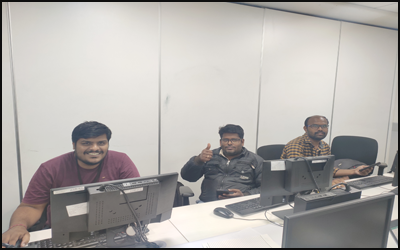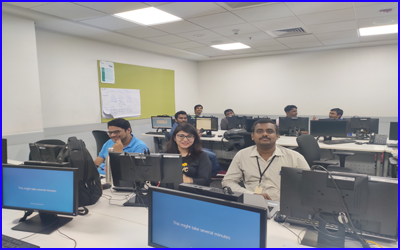8000+
Certified Learners
15+
Years Avg. faculty experience
40+
Happy Clients
4.5/5.0
Average class rating
What is Traefik?
Traefik is a modern, open-source reverse proxy and load balancer that is designed to handle dynamic environments, especially those in containerized or microservices-based architectures. It's built to automatically discover services, manage routing, and handle traffic across multiple hosts and different infrastructure platforms.
Some key features of Traefik include:
- Secure distribution: Traefik uses cryptography to ensure that updates are distributed securely, even over untrusted networks.
- Consistent updates: Traefik ensures that clients receive consistent updates, regardless of where they are located or what network they are on.
- Rollback support: Traefik allows clients to roll back to a previous version of software if a new version is found to be faulty or malicious.
- Flexible trust models: Traefik supports a range of trust models, allowing clients to decide how much they trust different update sources and how they should prioritize them.
- Multi-platform support: Traefik supports multiple platforms and can be used to secure software updates on a range of operating systems and hardware architectures.
Why Traefik is important?
Traefik is important for several reasons in the context of modern software development and deployment:
- Containerization and Microservices: With the rise of containerization and microservices architectures, where applications are broken down into smaller, independently deployable services, Traefik provides a crucial piece of infrastructure for managing the routing and communication between these services. It simplifies the complexities of service discovery and routing in dynamic environments.
- Automation and Scalability: Traefik's ability to dynamically configure itself and adapt to changes in the infrastructure enables automation and scalability. As services are added, removed, or scaled up or down, Traefik can automatically adjust its routing rules and load balancing configurations without manual intervention, saving time and effort for developers and operators.
- Security and TLS Encryption: Traefik's built-in support for automatic HTTPS configuration using Let's Encrypt or other certificate authorities enhances security by encrypting traffic between clients and services. This ensures that communication over the network is secure, protecting sensitive data and reducing the risk of unauthorized access or data breaches.
- Compatibility and Flexibility: Traefik's compatibility with a wide range of infrastructure platforms, including Docker, Kubernetes, Mesos, and more, makes it a versatile choice for organizations using different technologies and environments. It also offers flexibility through its support for various middlewares, allowing users to customize its behavior according to their specific requirements.
- Monitoring and Insights: Traefik's web interface and dashboard provide real-time metrics, configuration management, and monitoring capabilities, allowing operators to gain insights into the health and performance of their infrastructure. This visibility enables proactive management and troubleshooting, leading to improved reliability and performance of services.
Traefik Course Feature
A comprehensive Traefik course should cover a range of topics to provide learners with a thorough understanding of how to effectively use Traefik in various environments. Here are some key features and topics that such a course might include:
- Introduction to Traefik: Provide an overview of what Traefik is, its features, and its importance in modern infrastructure and application deployment.
- Installation and Setup: Guide learners through the process of installing and configuring Traefik in different environments, such as Docker, Kubernetes, or standalone setups.
- Basic Configuration: Cover the basics of configuring Traefik, including defining frontend and backend services, setting up routers, and managing traffic routing rules.
- Dynamic Configuration: Explain how Traefik handles dynamic configurations and integrates with service discovery mechanisms like Docker, Kubernetes, Consul, etcd, etc.
- Load Balancing: Explore Traefik's load balancing capabilities and how to configure load balancing algorithms, health checks, and circuit breakers to ensure high availability and optimal performance.
- Automatic HTTPS: Demonstrate how to configure Traefik to automatically provision and manage HTTPS certificates using Let's Encrypt or other certificate authorities.
- Middleware: Discuss Traefik's middleware support and how to use middlewares for functionalities like request rewriting, authentication, rate limiting, and more.
- Monitoring and Logging: Cover monitoring and logging capabilities in Traefik, including how to collect and analyze metrics, monitor traffic, and troubleshoot issues.
- Security Best Practices: Provide guidelines and best practices for securing Traefik deployments, including authentication, access control, TLS encryption, and protection against common security threats.
- Integration with Other Tools: Explore how Traefik integrates with other tools and technologies commonly used in modern infrastructure, such as Prometheus for monitoring, Grafana for visualization, and more.
Training objectives of Traefik
Traefik, a popular open-source reverse proxy and load balancer, is often used in microservices architectures and containerized environments like Kubernetes. The training objectives for Traefik can vary based on the target audience and their specific needs, but generally include:
- Installation and Configuration: Understanding how to install and configure Traefik to work within your infrastructure, whether it's a standalone server or a container orchestration platform like Kubernetes, Docker Swarm, or Nomad.
- Routing and Load Balancing: Learning how to set up routing rules and load balancing configurations to efficiently distribute incoming traffic across multiple backend services. This involves understanding Traefik's dynamic routing capabilities and how to define rules based on request attributes.
- TLS Termination and SSL Offloading: Configuring Traefik to terminate TLS connections and handle SSL certificates, ensuring secure communication between clients and backend services. This includes managing Let's Encrypt integration for automatic certificate provisioning and renewal.
- Service Discovery and Auto-Scaling: Integrating Traefik with service discovery mechanisms like Kubernetes service discovery, Consul, or etcd to dynamically discover backend services and automatically adjust routing configurations as services scale up or down.
- Middleware Configuration: Utilizing Traefik's middleware functionality to add additional features like request rewriting, rate limiting, authentication, and logging. Understanding how to configure middleware chains to apply multiple transformations to incoming requests.
- High Availability and Fault Tolerance: Setting up Traefik in a high availability configuration to ensure resilience against failures and handle traffic spikes gracefully. This may involve deploying multiple instances of Traefik and configuring them to share state or using external load balancers.
- Monitoring and Logging: Configuring Traefik to collect metrics and logs to monitor its performance and troubleshoot issues. Integrating with monitoring solutions like Prometheus and logging solutions like ELK (Elasticsearch, Logstash, Kibana) stack or Fluentd.
- Security Best Practices: Implementing security best practices when deploying Traefik, such as access control, rate limiting, and protection against common web vulnerabilities like CSRF (Cross-Site Request Forgery) and XSS (Cross-Site Scripting).
- Upgrades and Maintenance: Understanding how to perform upgrades to newer versions of Traefik and maintain the health and performance of Traefik deployments over time. This includes managing configuration changes and handling backward compatibility issues.
- Customization and Advanced Features: Exploring advanced features of Traefik and customizing its behavior to meet specific requirements, such as customizing routing logic, integrating with external authentication providers, or extending Traefik with custom plugins.
Traefik Target audience
The target audience for Traefik typically includes:
- DevOps Engineers: DevOps engineers are often responsible for designing, deploying, and maintaining the infrastructure that hosts microservices and containerized applications. They use Traefik to manage routing, load balancing, and traffic shaping in these environments.
- System Administrators: System administrators who manage web servers, load balancers, and networking infrastructure may also use Traefik to simplify the process of configuring and managing reverse proxy and load balancing services.
- Site Reliability Engineers (SREs): SREs focus on ensuring the reliability, availability, and performance of services in production environments. They may use Traefik to implement high availability configurations, monitor traffic, and troubleshoot issues related to traffic routing and load balancing.
- Developers: Developers who build microservices-based applications or containerized applications can benefit from understanding Traefik to define routing rules, manage SSL/TLS termination, and integrate with service discovery mechanisms.
- Container Orchestration Platform Users: Users of container orchestration platforms like Kubernetes, Docker Swarm, or Nomad often use Traefik as an ingress controller or edge router to manage external access to services running in the cluster.
- Networking Professionals: Networking professionals interested in software-defined networking (SDN) and modern networking technologies may explore Traefik as a solution for implementing reverse proxy, load balancing, and routing functionalities in distributed architectures.
- Security Professionals: Security professionals may be involved in configuring Traefik to implement security measures such as TLS termination, access control, and rate limiting to protect against threats like DDoS attacks, injection attacks, and unauthorized access.
- Cloud Architects: Architects responsible for designing cloud-native applications and infrastructure may incorporate Traefik into their designs to provide scalable and resilient traffic routing and load balancing capabilities in cloud environments.
Traefik Training methodology
A comprehensive training methodology for Traefik should encompass various learning approaches to cater to different learning styles and levels of expertise. Here's a suggested methodology:
- Introduction to Traefik: Start with an overview of what Traefik is, its key features, and its role in modern application deployments. Provide context on why Traefik is used and its advantages over traditional reverse proxies and load balancers.
- Conceptual Understanding: Break down the fundamental concepts behind Traefik, including reverse proxying, routing, load balancing, service discovery, and middleware. Use diagrams and real-world examples to illustrate these concepts.
- Hands-on Installation and Configuration: Walk learners through the process of installing Traefik in different environments, such as standalone servers, Kubernetes clusters, Docker Swarm, or cloud platforms. Provide step-by-step guides and hands-on labs for configuring basic settings, such as defining entry points, routers, and services.
- Scenario-based Exercises: Design exercises and scenarios that simulate real-world use cases to reinforce learning. For example, configuring HTTPS termination with Let's Encrypt, implementing routing rules based on request headers, or integrating Traefik with service discovery mechanisms.
- Documentation and Reference Materials: Encourage learners to explore Traefik's official documentation and reference materials to deepen their understanding and troubleshoot issues independently. Highlight key sections of the documentation and provide guidance on how to navigate and interpret it effectively.
- Interactive Demos and Tutorials: Supplement traditional learning materials with interactive demos and tutorials that allow learners to experiment with Traefik in a sandbox environment. Provide guided walkthroughs and explanations to help learners understand the underlying concepts and commands.
- Case Studies and Use Cases: Showcase real-world case studies and use cases where Traefik has been successfully deployed to solve specific challenges or achieve certain objectives. Discuss best practices, lessons learned, and considerations for each case study.
- Q&A Sessions and Discussion Forums: Host live Q&A sessions or online discussion forums where learners can ask questions, share experiences, and seek assistance from instructors and peers. Encourage active participation and collaboration to foster a supportive learning community.
- Certification and Assessments: Offer certification programs or assessments to evaluate learners' proficiency in using Traefik effectively. Design exams or practical assignments that assess learners' ability to configure Traefik for various deployment scenarios and troubleshoot common issues.
- Continuous Learning and Updates: Emphasize the importance of staying updated with the latest features, best practices, and community developments related to Traefik. Provide resources for ongoing learning, such as webinars, blog posts, and community forums.
Traefik Training materials
Developing comprehensive training materials for Traefik involves creating resources that cater to various learning styles and proficiency levels. Here's a suggested list of training materials:
- Slides or Presentations: Create slide decks or presentations covering key concepts, features, and configurations of Traefik. Include visuals, diagrams, and examples to aid understanding.
- Documentation Guides: Provide detailed documentation guides that walk participants through the installation, configuration, and usage of Traefik. Include step-by-step instructions, command-line examples, and configuration samples.
- Hands-on Labs: Develop hands-on lab exercises that allow participants to practice configuring Traefik in a controlled environment. Provide lab instructions, pre-configured environments, and exercises covering various use cases and scenarios.
- Video Tutorials: Produce video tutorials demonstrating Traefik installation, configuration, and usage. Break down complex concepts into digestible segments and provide visual demonstrations of Traefik in action.
- Interactive Demos: Offer interactive demos where participants can explore Traefik's features and functionalities in a sandbox environment. Include guided walkthroughs and interactive prompts to help participants navigate the demo.
- Case Studies: Present real-world case studies showcasing how Traefik is used in different industries and environments. Discuss challenges faced, solutions implemented, and the benefits realized by using Traefik.
- Reference Guides: Compile reference guides summarizing Traefik's configuration options, command-line parameters, and best practices. Organize information in a structured format for quick lookup and easy reference.
- FAQs and Troubleshooting Guides: Create FAQs and troubleshooting guides addressing common questions, issues, and pitfalls encountered when working with Traefik. Offer troubleshooting tips, error message explanations, and resolutions to common problems.
- Community Forums and Resources: Provide links to Traefik's official documentation, community forums, discussion groups, and online resources. Encourage participants to explore additional resources and engage with the Traefik community for support and knowledge sharing.
- Quiz and Assessment Materials: Develop quizzes, assessments, or knowledge checks to evaluate participants' understanding of Traefik concepts and configurations. Include multiple-choice questions, scenario-based exercises, and practical assignments.


